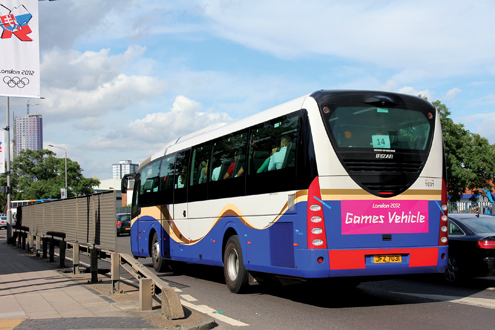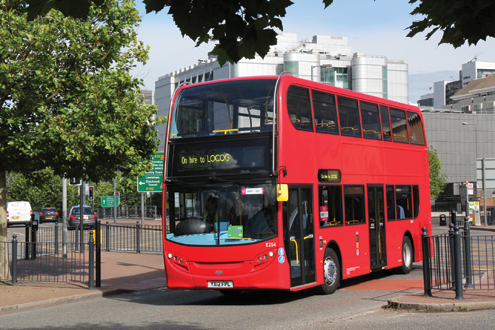
By Doug Jack
The United Kingdom took great pride in the outstanding success of the London Olympics. We were delighted at the favorable reviews in the international press and take credit for the fact that when it comes to staging major events, we have the people and the skills to do it very well.

When London was awarded the 2012 Olympics five years ago, planning started immediately. The government opted to build the main arena, several smaller venues, the village for the athletes and a major media center in a run-down part of East London — not a glamorous part of the capital. The site was close to the main railway line linking London to the Channel Tunnel into continental Europe.

Most of the events were held in London but not all at the Olympic park. With Transport for London being responsible for all the services in the capital, one of the objectives was to make London 2012 a model for sustainable travel. The authorities wanted as many spectators as possible to use public transport and made provisions for people traveling by car from outside the capital to reach large temporary park-and-ride sites.
Transport for London calculated that on the busiest days it would make an extra three million journeys in the capital, a 25 percent increase on normal demand. As a result, the underground rail network maintained the normal peak period service levels throughout the day with extensions into the evening to enable people to return from events.
All the regular bus services in the vicinity of the Olympic venues were reviewed, with frequencies increased during the Olympics in quite a number of cases. High capacity double deck buses replaced the regular midibuses.
Transport for London also made special supplemental arrangements to transport nearly 15,000 athletes and around 21,000 journalists and broadcasters to and from events in a dedicated fleet of buses.
The contract went to Stagecoach, which employed 500 of its own vehicles and another 500 subcontracted from other fleets across the country, with quite a large contingent coming from Ulsterbus of Ireland.
Only the United Kingdom and Ireland drive on the left in Europe, apart from Malta and Cyprus, so all the additional vehicles had to be located within the country. Stagecoach normally orders around 600 new buses each year for its British operations.

In preparation for the Olympics, Stagecoach asked its fleets around the country to contribute vehicles and drivers for the Olympic services. They were told to ready their vehicles in reserve for use during the Olympics, covering for newer vehicles, including some delivered to London straight from manufacturers. This required some very careful planning and route training for drivers drafted in from all over the country.
With very few exceptions, the United Kingdom does not have dedicated buses solely for school and student transport. Regular bus fleets, including the subsidiaries of Stagecoach and the companies that they brought in to help with the contract, provide these services. Because schools, colleges and universities were on summer vacation, most fleets around the country could spare a few drivers each. Some came from as far as northern Scotland, where the main road hazard is usually stray sheep. They must have found London quite a different place.
Accommodation was another potential problem, with many hotels hiking their rates in anticipation of an Olympic bonanza. As it turned out as the Games approached, bookings were low and hoteliers actually had to slash their prices.
Stagecoach solved the accommodation problem in an ingenious way by hiring cruise liners, which it moored on the Thames close to the main Olympic transport hubs.
FirstGroup also secured major contracts. One was for 300 coaches to provide express services to transport hubs in London and at various regional centers. For instance, sailing was at Weymouth on the south coast. FirstGroup provided some of its own vehicles, but also hired in from other companies.
FirstGroup also secured a contract for 500 buses to provide transport between park-and-ride sites and the various events. Just like Stagecoach, it took newer vehicles from many of their fleets around the country, temporarily replacing them with older vehicles due for withdrawal. About two weeks before the Olympics opened, I heard a traffic news item on the radio advising motorists that a convoy of 60 double deck buses was progressing along one of the main motorways toward London.
As the Olympics approached, many special lanes were marked out on London’s roads to speed the journeys of official cars and Olympic buses. Unauthorized vehicles faced heavy fines if they strayed into those lanes. In many cases, congestion was less than usual, helped to some extent by Londoners going on holiday during the Games or opting to work from home.
The International Olympic Committee is very protective of its main sponsors, to the extent that official contractors had to remove fleet names from their vehicles. Many of the FirstGroup double deck buses ran in a corporate livery with a large “Shuttle” brand on each side. There were even reports that some had to temporarily cover over the manufacturers’ badging.
One week before the Games started, Transport for London was confident that it could get everyone to and from the Games on time and also keep the rest of London moving. It placed additional information on many bus stops in the capital and temporary stops for the media, along with staff on the streets acting as Olympic ambassadors and helping the traveling public.
Transport for London already had CentreComm, a control center for buses running in the capital, along with a Transport Coordination Centre on the same site at a cost of $15 million. It brought together the bus fleets, Games organizers and other relevant authorities to ensure a coordinated response to any incident which caused disruption to the transport system, including re-routing if necessary. Fortunately, everything ran remarkably smoothly and everyone learned valuable lessons in cooperation.
At the time of this writing, the Paralympics are still to come. Though on a smaller scale, they will make their own unique demands on public transport. All the buses used to carry athletes will have low floors only one step above the ground with ramps to the adjacent sidewalk.
Around 400 buses are being adapted with tracking in the floor to enable clamping and securing six wheelchairs safely in place — a major logistics exercise carried out in a remarkably short time between the closure of the Olympic Games and the opening of the Paralympics.
After the closing ceremony for the Olympics and all the athletes and visitors had gone home, Transport for London and its contractors were delighted that their plans had worked so well. It was a major boost to the credentials of the bus industry, which is often in the shadows of our heavily subsidized railways.
Regrettably, the strict rules of the International Olympic Committee prevent any contractor, other than an official sponsor, from generating any publicity about its participation in the Games. The bus industry needs a higher public profile and should be able to make more of its great success at the Olympics.

Nevertheless, the Chartered Institute of Transport and Logistics issued a press statement, saying that the logistics and transport industry was able to demonstrate its ability to operate efficiently, economically and with a highly effective service to industry and consumers. It announced its moving record numbers of passengers during a period complicated by increased demand, road and traffic restrictions and heightened security.
“The challenge now is to ensure that the operational lessons learned during this period are consolidated into future best practice for the benefit of London’s businesses, consumers, road users, residents and visitors,” said the chief executive. “All such best practice learnings should also be applied to other parts of the United Kingdom.” BR
Doug Jack is with Transport Resources in the United Kingdom.
